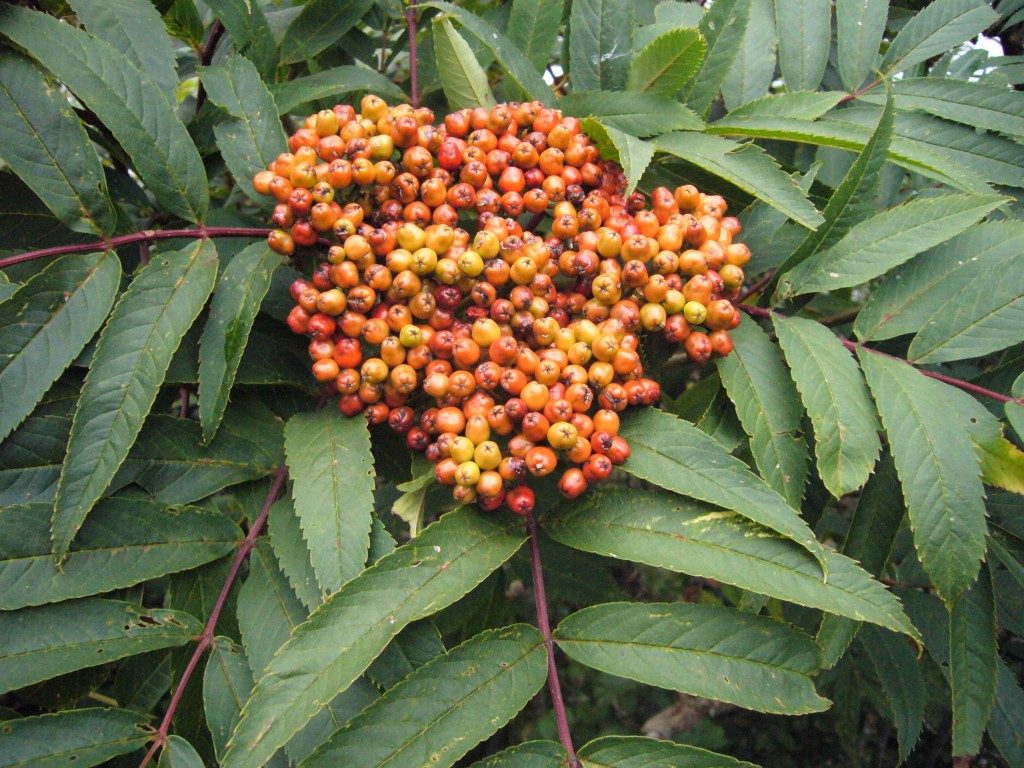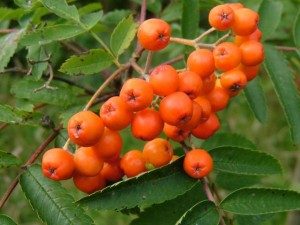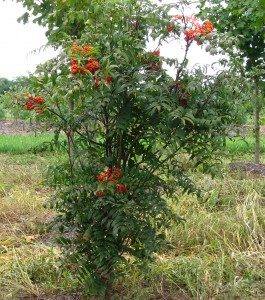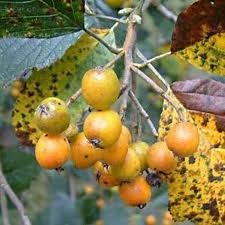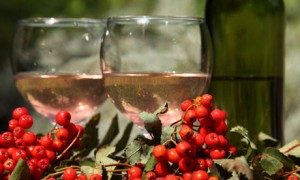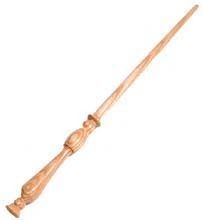Long before Henry Potter Rowanwood wands were popular ancients carried talismans of the tree to ward off evil and ate the fruit. Well… sort of.
Rowan is another name for the European Mountain Ash. Mountain ashes around the world tend to fall into two groups. One group has berries that are usually processed into jelly or jams and are barely edible off the tree after frost if not after freezing a few times or a long stint in your freezer. Raw their quality is not great. The other group has been bred to be eaten raw and can also be made into various sweet products. So the fruit is edible but… You will read in some places that the seeds contain compounds which upon digestion release small amounts of cyanide. This is probably true. The seeds of some 1,000 plants in the greater group (Rose) do have some cyanidic compounds. Processing (the breaking down of cell structures and letting enzymes go to work) and or cooking usually take care of that issue. Small amounts of raw fruit are considered tolerable and to my knowledge there are no bad cyanide-related reports about Mountain Ash fruit. Man probably discovered these fruit — and their necessary vitamin C — were edible in the winter time because they persist on the tree and taste better the older they get (which additionally might reduce the potential cyanide amount.) The berries also contain malic acid and parasorbic acid. Malic acid is what makes apples tart. Parasorbic acid can upset the tummy raw but cooking changes it to sorbic acid which is not a problem.
While traipsing around the Blue Ridge Mountains in August I saw two mountain ashes, the American and the European. They look very similar and live to around 25 or 30. The American has red stems near the end of branches, the European yellowish stems. However they are used the same way. In fact, there are at least 10 to 18 edible members in the genus depending on the definition and who’s counting.
The American Mountain Ash, Sorbus americana, (SOR-bus ah-mare-ree-KAY-nah) is found in the wilds of eastern North America: Newfoundland and Nova Scotia south to New Jersey and Pennsylvania and in the mountains to South Carolina and Georgia, west to Minnesota and eastern North and South Dakota. Elevation is the key. In New England most American Mountain Ash are found in the White Mountains from 2,310 to 4,290 feet.) In the Adirondack Mountains of New York it rarely occurs below 3,135 feet. In the Blue Ridge Mountains I saw them between 3,000 and 4,000 feet. They like cool, humid climates. Not a true ash they are called that because while closely related to the apple their leaves resemble those of ashes (Fraxinus spp.) Unlike the true ash, however, the American Mountain Ash’s leaves are alternate, not opposite.
Native American made much use of the related Mountain Ashes for food. The Algonquin, Quebec, Montagnais and Ojibwa ate Sorbus americana berries, the Thompson, Sorbus sitchensis and the Heiltzuk, Sorbus sitchensis var. grayi. Usually the berries were dried then ground and added to four or soups and the like. To that North American list Lee Peterson also adds Sorbus decora, called the Northern Mountain Ash; Cornucopia II adds the Western Mountain Ash, Sorbus scopulina. Across the Atlantic the European Mountain Ash, Sorbus aucuparia, was used for food as well as the Sorbus latifolia which oddly has yellow fruit with black dots. In Eurasia there’s Sorbus domestica, Sorbus aria, which has brown berries with red spots, and Scorbus torminalis which looks similar to S. aria. There are also several cultivars of the various species: Rabina, Rosina, Edulis, Moravica, Rossica, Apple, Pear, and Devoneinsis. These tend to have larger, better tasting fruit.
The berries of the wild versions are often made into jellies or cooked with meat. When young and raw their flavor is sharp and not pleasant. This moderates on aging. Cultivated versions are often eaten raw. The berries are full of pectin. Nutritionally they’re about 5.5 percent protein, 8 percent fiber, and high in iron and vitamin C. There’s also a good amount of vitamin A. Per pound there are some 388,000 seeds. They need to be chilled at 33 to 41 degrees F. for 60 or more days to germinate.
The tart berries have been used for home remedies including a gargle for sore throats and to treat scurvy and malaria. Efficacy of the latter, however, is doubtful as it was used only because the leaves resembled the Quinine tree which was used for fevers.
The Harry Potter series borrowed ancient Celtic views towards the European Mountain Ash also called the Rowan Tree. The Celts and other people of early British Isles thought the tree had magical properties. Its powers were to protect you from witchcraft, one of two reasons why it is also called Witchwood. The other reason is a pucker at the end of the fruit reminds some of a pentagram which is associated with witchery.
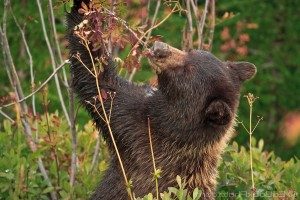
Black Bear Cub eating Mountain Ash Berries, photo by Ed Book.
As one might think, animals also know the mountain ashes as food. It is a favored browse of moose and white-tailed deer. Bears, fishers and martens like it as well as snowshoe hares, squirrels, small woodland rodents, the ruffed grouse, ptarmigans, sharp-tailed grouse, blue grouse, American robins, thrushes, waxwings, and jays. It’s also the preferred food for the (despised) gypsy moth larvae.
Sorbus (SORE-bus) is Dead Latin for “service tree” which was actually a dogwood. Americana means of North America. The European Mountain Ash’s name is a bit more interesting, “aucuparia” ow-kew-PAH-ree-ah. It means “to catch a bird.” Fowl like the fruit and were caught at the tree. “Rowan” means “becoming red” and is from the Germanic word raudnian.
European Mountain Ash Wine, courtesy of John Wright and The Guardian
2kg rowanberries, snipped off with scissors, picked over and washed
1.2kg sugar
500ml white grape juice concentrate
Juice of 2 lemons
1 tsp of wine tannin
1 tsp pectolase
1 tsp yeast nutrient
Sachet of white wine yeast
About 4 litres of boiling water
Put the berries in a food grade plastic bucket and mash them coarsely. Boil the water then stir in the sugar until dissolved, bring to the boil again and immediately pour over the berries. Cover and allow to cool. Add the grape concentrate, pectolase, lemon juice and tannin. Cover and leave for 24 hours then stir in the yeast nutrient and yeast (activated if necessary).
Cover and leave for a week, stirring every day for the first five days. If your brew has separated nicely into three layers – sludge / liquid / sludge – carefully place the end of a siphon at a strategic height and siphon off the liquid into a clean demi-john – though a bit of sludge won’t hurt. Otherwise strain through clean muslin using a funnel. Top up to the bottom of the neck with boiled and cooled water if necessary. Fit the fermentation lock and leave to ferment for a couple of months.
Rack off into a fresh demi-john and leave until all fermentation has stopped for a week, then bottle. Rowanberry wine benefits from a long maturation period in the bottle – at least a year
Green Deane’s Itemized Plant Profile: American Mountain Ash
IDENTIFICATION: Sorbus americana: A small tree to 40 feet, usually shorter. Leaves alternate, pinnately compound, 6 to 10 inches long, 11 to 17 lance-shaped, serrated leaflets, 2 to 2 1/2 inches long, dark green on top, paler on bottom. In the top photograph the leaflets are opposite but the leaves alternate. Showy clusters of small white flowers, clusters 3 to 5 inches across. Fruit: Clusters of showy, red, small (1/4 to 3/8 inch in diameter) pomes. The bark yields a gray dye.
TIME OF YEAR: Flowers late spring to early summer, fruit late summer to fall, persist through the winter.
ENVIRONMENT: Cool, moist habitats, borders of swamps, rocky hillsides, in openings or in woods, upland roadsides or under semi-open stands of birches, fir and spruce. Prefers full sun.
METHOD OF PREPARATION: Berries of the wild varieties made into jams, jelly, syrups, conserves, wine, vinegar, eaten raw after frost or a freeze. Berries of cultivated versions eaten when ripe. Often cooked with meat. Can be used to thicken other jellies. Jelly goes well with sharp cheese. Dried ground berries can be added to flour to make bread. Use can vary significantly from species to species. For example, the leaves and flowers of the American Mountain Ash are not used but the leaves and flowers of the European Mountain Ash (also planted in North America) can be used for tea.

